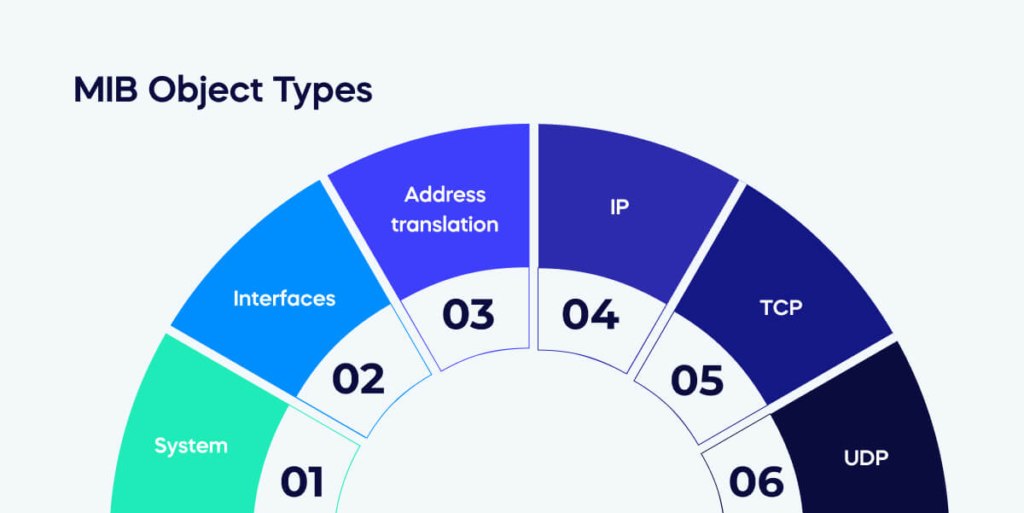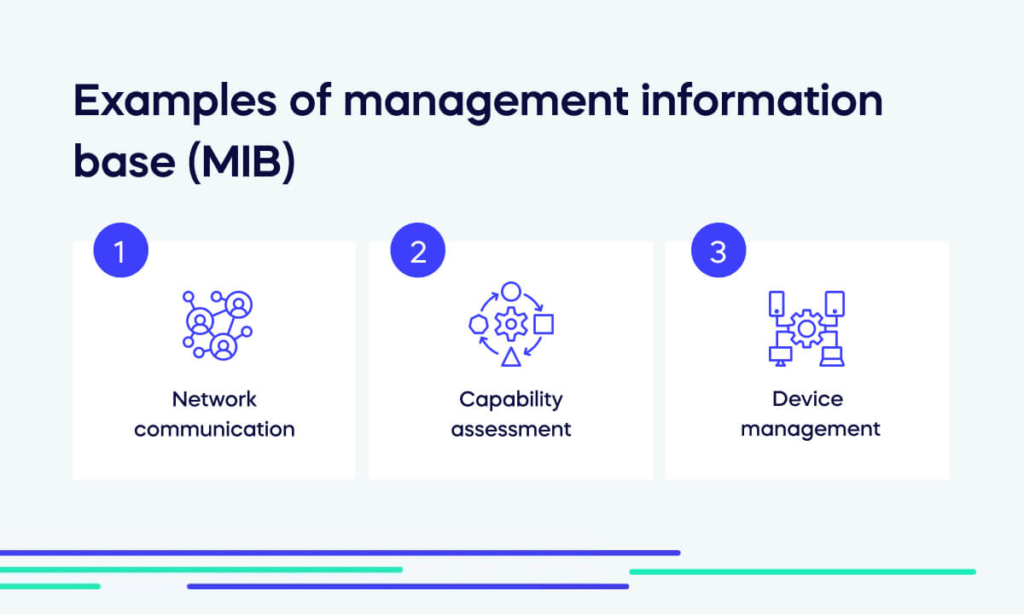A management information base is a hierarchically structured database that holds data objects relating to a device under the surveillance of a Network Management System (NMS).
The NMS keeps track of nodes by remotely accessing the values of the managed resources archived in the MIB, with each entity identified by an Object Identifier (OID).
In today’s hybrid work environment, organizations face various novel challenges. These include managing a widely dispersed and mobile workforce, grappling with varying degrees of connectivity quality, and the urgent need to deploy tools that enable collaboration, remote onboarding, monitoring, and business continuity.
Consequently, network management systems must exhibit agility, incorporating inherent intelligence and automation platforms to streamline decision-making processes and mitigate errors. Security must be embedded and accorded priority to ensure that network management platforms and the devices tethered to them maintain robust security from the core to the perimeter.
How does a management information base work?
A management information base is often associated with a simple network management protocol, an established open standard protocol for network management.
SNMP fundamentally operates as a dedicated request/reply protocol, encompassing two types of request messages: GET and SET. The former is used to extract existing data from a node, while the latter is used to input and store new data in a node.
When a network administrator selects a specific piece of information they want to view, the SNMP protocol requests this data from the relevant node. An SNMP server, active on the node, receives the request, finds the requisite data, and returns it to the client program, which subsequently displays it to the user.
However, how does the network administrator specify the information it seeks to retrieve, and conversely, how does the server determine which memory variable to read to fulfill the request?
The resolution lies in SNMP’s reliance on a management information base (MIB), which outlines the distinct pieces of information—or MIB variables—that can be retrieved from a network node.
What are MIB Object Types?

A managed object, also known as an MIB object or simply an object, represents one of the numerous specific attributes of a managed device. Managed objects are made up of variables called object instances. An OID uniquely identifies and distinguishes each managed object within the MIB hierarchy.
These variables are organized into different groups:
System
When considering the overall system (or node), several key parameters must be considered. These include the precise geographical location of the node, the duration for which it will remain operational, and the unique name assigned to the system. Paying attention to these specific details ensures a comprehensive understanding and effective management of the entire system.
Interfaces
The data includes information about all network interfaces (adaptors) connected to the node. This includes details such as the physical address of each interface, as well as the number of packets that have been sent and received through each interface. By providing these comprehensive statistics, administrators can better understand network performance and usage.
Address translation
Here is some information pertaining to the Address Resolution Protocol (ARP). ARP is a protocol used for mapping an IP address to a physical or MAC address on a local network. One of the key components of ARP is its address translation table, also known as the ARP cache.
This table stores the mappings between IP addresses and MAC addresses, allowing devices to communicate with each other at the data link layer. The address translation table is dynamic and constantly updated as devices join or leave the network, ensuring accurate and efficient communication within the network.
IP
Variables related to IP include its routing table, which determines the path for forwarding datagrams. Information about the number of successfully forwarded datagrams and datagram reassembly statistics is also captured. This includes instances when IP discards a datagram, whether due to fragmentation issues, invalid headers, or other reasons. These variables provide valuable insights into the performance and behavior of IP in network communications.
TCP
Data concerning TCP connections, such as counts of passive and active opens, the number of resets, the number of timeouts, default timeout settings, etc., per-connection data, persists only while the connection is active. This means that the information is continuously updated and available as long as the connection remains established and operational, ensuring accurate and real-time insights into the connection’s performance and characteristics.
UDP
Here are some details about UDP (User Datagram Protocol) traffic, which involves the transmission and reception of UDP datagrams. UDP is a connectionless protocol widely used in network communication. It provides a lightweight and fast method for sending datagrams over IP networks. The cumulative number of UDP datagrams sent and received is a crucial metric for monitoring the efficiency and reliability of UDP-based applications and network connections.
What is the purpose of a management information base (MIB)?
The purpose of a management information base is to store information about SNMP devices.
IT teams deploy SNMP management software on a designated computer—the managing entity or management system—to extract vital data from the managed devices, such as configuration settings and online status.
Depending on the specific equipment being managed, this information may vary. For instance, when monitoring a switch, the data might encompass the volume of inbound/outbound traffic, the total number of occupied ports, packet loss rate, etc.
These snippets of management information are accessible as data objects in a device’s MIB file.
Typically, networking equipment manufacturers embed these files into their devices, like routers and switches, to streamline the process for IT administrators in monitoring the devices’ availability status and hardware performance.
What is the difference between a management information base (MIB) and a database?
The network management system (NMS) database is a tangible database that holds the values of network objects and can be implemented using any proprietary database software.
Conversely, a Management Information Base (MIB) is a virtual database utilized by network management and agent applications for exchanging information concerning network objects.
Why do I need a management information base (MIB)?
The primary function of a management information base is to convert numerical strings into text easily understandable by humans.
A management information base functions as a specialized virtual database designed to store information about the monitored devices within a network. In essence, an MIB acts as the dictionary for the SNMP language, ensuring every managed object referenced in an SNMP message is cataloged in the MIB.
When a device utilizing SNMP sends a message or “trap,” it denotes every data object within the message with a numerical string known as an object identifier or OID.
This makes a management information base an essential infrastructure service as it can assist with the management and upkeep of network components of your information technology services.
What is the structure of a management information base (MIB)?
A management information base possesses a hierarchical tree structure wherein individual nodes symbolize distinct network objects. Each node is recognized by a unique Object Identifier (OID), constituting a series of numbers traversing down the tree branches from the root to the specific node.
Examples of management information base (MIB) use cases

To harness the full potential of the management information base (MIB), it is crucial to comprehend its practical applications in the real world.
MIB has been used extensively in various industries, including networking, telecommunication, and security.
Below are some applications and use cases of a management information base that will explain why they should become part of your IT strategy:
Network communication
The primary function of the MIB is to facilitate seamless communication between managed network devices. The managing entity utilizes the MIB file of a specific managed device to interpret its messages.
This file uniquely identifies every data object in the message with a numerical string, known as an object identifier (OID), and allocates an appropriate text label. The management system uses this file to render OID numbers into human-readable text.
The absence of these files would render the messages received meaningless numerical strings. Loading standard and device-specific files into the management system is vital for uninterrupted communication and message translation.
Capability assessment
MIB files aid IT administrators in evaluating managed devices’ capabilities and potential issues. IT engineers might struggle to discern the various traps a device can emit without directly inspecting its components.
Traps are messages a device sends to the management system under predetermined conditions, such as configuration anomalies or exceeding certain thresholds. If a device component’s details are absent in the MIB file, it cannot relay specific alerts about that component to the managing entity.
For instance, a switch lacking port details in its MIB file could not send overload-related port traffic alerts.
Device management
Every SNMP device contains multiple OIDs or data objects. Managing the numerous OIDs across various network devices can be arduous and often impractical for IT personnel.
A management information base file consolidates all the objects of a specific device in one place, enabling swift discovery and management by IT engineers. They can also employ an MIB browser, a specialized SNMP network management tool, for managing these files and associated devices.


